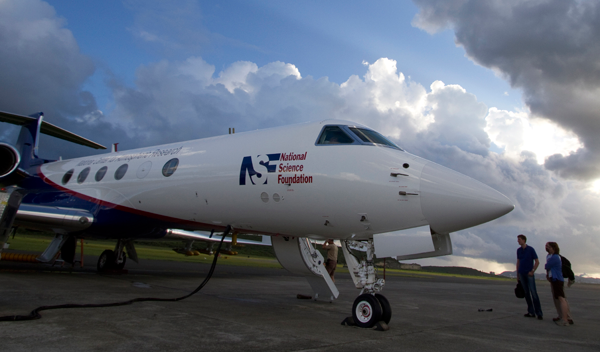NSF/NCAR research plane assisting with U.S. hurricane forecasts
Partnership with NOAA will help protect vulnerable communities
Aug 30, 2016 - by Staff
Aug 30, 2016 - by Staff
BOULDER, Colo. — As the peak of hurricane season approaches, U.S. forecasters are deploying a high-altitude research aircraft operated by the National Center for Atmospheric Research (NCAR) to fly over and around storms to take critical observations.
 The NSF/NCAR Gulfstream-V readies for takeoff on a mission to study tropical storms. (©UCAR. Photo by Carlye Calvin. This image is freely available for media & nonprofit use.)
The NSF/NCAR Gulfstream-V readies for takeoff on a mission to study tropical storms. (©UCAR. Photo by Carlye Calvin. This image is freely available for media & nonprofit use.)
The deployment this week of the Gulfstream-V (G-V) aircraft is the result of a partnership between the National Science Foundation (NSF), which owns the plane, and the National Oceanic and Atmospheric Administration (NOAA), which issues forecasts. The NSF/NCAR G-V will take to the skies to support hurricane forecasts through October 12, while NOAA’s Gulfstream-IV (G-IV) undergoes unscheduled maintenance.
"It's critical to have detailed measurements of the atmosphere around a hurricane in order to ensure that forecasts are as accurate as possible," said Antonio (Tony) J. Busalacchi, president of the University Corporation for Atmospheric Research, which manages NCAR on behalf of NSF. "NCAR and its research partners have a proven track record of improving predictions of dangerous storms. Consistent with our role of managing NCAR, we take very seriously our ability and responsibility to share our advanced resources in support of NOAA's mission to protect life and property."
"NSF is pleased that NCAR, using the G-V, is able to assist in this potentially lifesaving activity," said Roger Wakimoto, assistant director of the NSF Directorate for Geosciences. "The data gathered will help refine future hurricane forecasts.”
Outfitted for critical observations
The NSF/NCAR G-V can fly at high altitudes and deploy the same specialized sensors as the NOAA G-IV. These sensors take critical observations of atmospheric conditions for the NOAA National Hurricane Center.
Studies show that such observations improve hurricane track forecasts in the U.S. global weather model (called the GFS) by about 15 percent during the 24 to 48 hours before landfall. Research also demonstrates that these data increase the accuracy of hurricane intensity forecasts.
To take the observations, the NSF/NCAR G-V has been outfitted with the Airborne Vertical Atmospheric Profiling System (AVAPS). The system releases parachute-borne sensors, known as GPS dropsondes, that measure ambient temperature, pressure, humidity, wind speed, and wind direction at different altitudes as they fall through the atmosphere. Dropsondes were first developed at NCAR in the 1970s with NSF funding and have since been regularly updated. NOAA was an early adopter of the dropsondes for hurricane surveillance missions and research, and the development of the AVAPS system design in the 1990s was motivated in part by the capabilities of the NOAA G-IV.
The NSF/NCAR G-V, which is available for flights over both the Atlantic and Pacific, will fly above a hurricane or other major storm at altitudes of up to 45,000 feet, as well as around the storm's edges. Its dropsonde launch system and software is similar to that of the NOAA G-IV.
NCAR pilots will guide the aircraft on pre-planned flight tracks, dropping sondes approximately every 15 minutes. Data from the sondes will be processed by a NOAA technician onboard the plane, then sent to the Global Telecommunications System for immediate inclusion in hurricane forecast models.
"It is a special privilege for us to be able to help out our colleagues at NOAA by deploying the NSF/NCAR G-V in the hurricane surveillance missions this season," said Vanda Grubišić, director of NCAR's Earth Observing Laboratory, which operates the G-V. "Our Research Aviation Facility crews look forward to working with their NOAA colleagues and collecting important data in support of their mission."